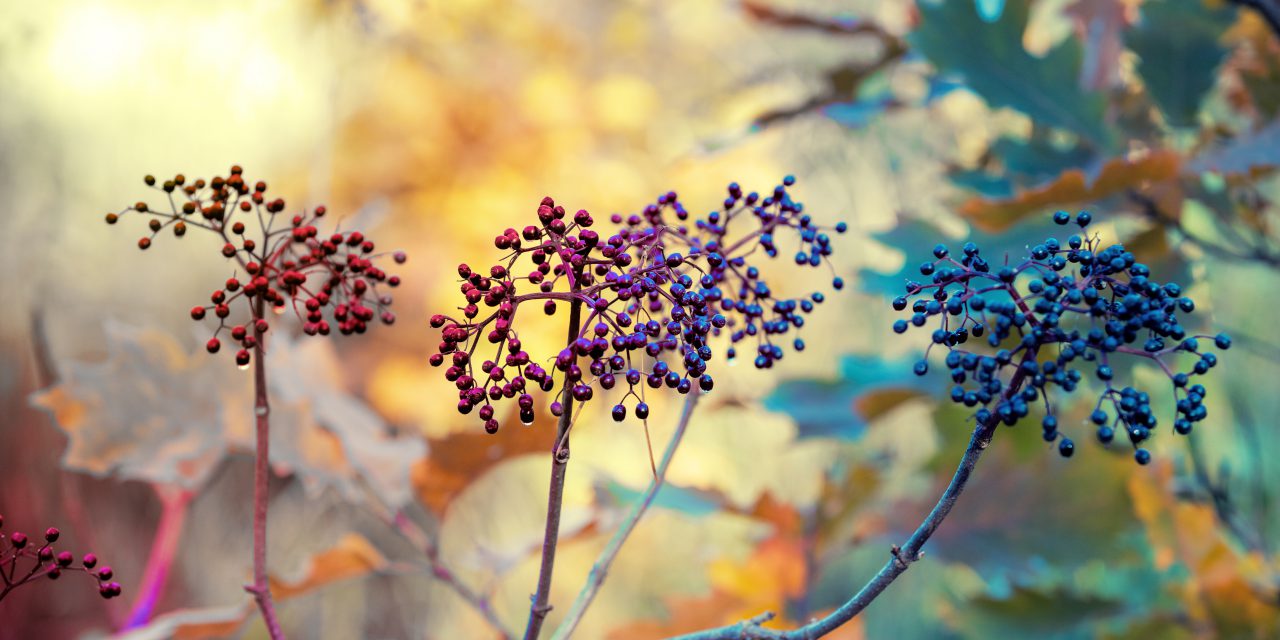
What is the Buzz About Elderberry?

Traditionally and from ancient times, elderberry, a small purple berry, has been used for upper respiratory infections, as well as colds and coughs and many bacterial or viral infections. Many other documented uses include: lowering cholesterol, treating arthritis, improving vision, boosting the immune system, and using it as an anti-inflammatory. In folk medicine, it has been used to also treat sinus congestion, constipation, diarrhea, sore throat, and rheumatism (Novelli 2003; Uncini Manganelli et al. 2005 ). The berries have also been used in preserves and drinks.
If you have the inclination, elderberries are pretty easy to grow. They are native to North America and Central Europe. The flowers are edible and the fruit is very high in Vitamin A, B and C, calcium, iron and vitamin B6. They also contain sterols, tannins, and essential oils.
Types of Elderberry Plants
Two of the most common types of elderberry plants include the European elderberry (Sambucus nigra) and the American elderberry (Sambucus canadensis). Both have phenolic compounds that include phenolic acid, flavonoids, catechizes, and pro-anthocyanidins (Barak et al). Be careful not to grow or use the red elderberry (Sambucus racemosa), because the berries of this version are poisonous. Generally, elderberry is well tolerated, although an allergic reaction is always possible. Typical allergic symptoms would include a runny nose, sneezing, stuffiness or shortness of breath in people allergic to grass pollen (Forster-Waldl, Clin Exp Allergy 2003). For the rest of us, purchasing elderberry from a reputable company is just as easy.
The black elder species came in third for its antioxidant capacity, as measured with the FRAP method in one study. (Halvorsen et al. 2002). Using the ORAC technique to measure the antioxidant potential of various small fruits, (Wu et al. 2004a, b) showed that the American elder had a much higher potential than cranberry and blueberry, which have very high anti-oxidant properties. Blueberries are usually number one on my list of foods for patients to eat when trying to reduce inflammation. Elderberry should be on the list too.
Elderberry and Influenza
Following earlier work done by Konlee (1998) and Zakay-Rones et al. (1995), these researchers reported that a mixture containing elderberry extract had an inhibitory effect on haemagglutinin found in mycovirus. More work done by Barak et al. (2001, 2002) demonstrated that such a mixture could inhibit the replication of 11 strains of the influenza virus and increase cytokines production. Assuming elderberry has the strength to inhibit 11 strains of influenza, this might be a great berry to study to determine whether it has an impact on corvid-19.
Influenza A virus (IFV) has been a common condition for the use of elderberry. IFV changes in its characteristics by antigenic mutation, making it difficult to find medications that are successful in the treatment. It is suspected that SARS-COV-2 is and will be difficult as well. We also don’t know yet about how it will mutate in the future.
Flavonoids in elderberry have been reported to bind to host cells and prevent IFV infection in vitro. (Roschek et al. 2003). The anti-IFV activity of phenolic compounds has been suggested to be due to their direct action on IFV.
Elderberry Juice
Study results suggest that concentrated elderberry juice would interact with the early stages of IFV viral replication, including viral attachment to and penetration into the host cells. (Biosci et al 2012). Elderberry has been reported to stimulate the immune system by enhancing the production of cytokines by monocytes. (Barak et al. 2001) The results suggest that flavonoids, which are responsible for the powerful anti-oxidative activity of elderberry, might contribute to the anti-IFV activity. Might this also work for COVID?
A considerable risk factor for infection and severity of symptoms with COVID is Diabetes mellitus. Interestingly, elderberry has proven beneficial in studies due to their capacity to stimulate insulin secretion and reduce oxidative stress (Magda et al). In a study on rats, the anti-inflammatory effects took place in as little as 48 hours and increased TNF-a and IFN-g levels in the diabetic group protected by extracts of elderberry. (Magda Badescu, et al.)
The Concern
The one big concern that seems to circulate around elderberry is the question whether or not it can increase a cytokine storm. Cytokines help communicate with the immune system to engage in action and move cells to a certain location. A cytokine storm occurs when a dysfunctional immune response then contributes to organ damage or death. There was a very small study that used blood from healthy donors and showed that elderberry extract increases the production of inflammatory cytokines in vitro. However, no other research agrees, and there is no evidence that elderberry induces cytokine storm syndrome in humans. Typical dosages range from 600-1000mg and have been used safely.
Today in the midst of the COVID-19 pandemic, many practitioners are discussing whether elderberry could be of some preventive or therapeutic benefit, as it has been shown to be with IFV. As I mentioned before, I believe this might be a great berry to study to determine whether it has an impact on COVID-19.
References
Barak V, Halperin T, and Kalickman I, Eur. Cytokine Netw., 12, 290–296 (2001).
Barak, V., S. Birkenfeld, T. Halperin, and I. Kalickman. 2002. The effect of herbal remedies on the production of human inflammatory and anti-inflammatory cytokines. Isr. Med. Assoc. J. 4:919–922.
Barak, V., T. Halperin, and I. Kalickman. 2001. The effect of Sambucol, a black elderberry-based, natural product, on the production of human cytokines: I. Inflammatory cytokines. Eur. Cytokine Netw. 2:290–296.
Baugerod, L.F. Andersen, J.O. Moskaug, D.R.J. Jacobs, and R. Blomhoff. 2002. A systematic screening of total antioxidants in dietary plants. J. Nutr. 132:461–471.
Emiko KINOSHITA,1;y Kyoko HAYASHI,2 Hiroshi KATAYAMA,1 Toshimitsu HAYASHI,2 and Akio OBATA1Biosci. Biotechnol. Biochem., 76 (9), 1633–1638, 2012 Anti-Influenza Virus Effects of Elderberry Juice and Its Fractions
Konlee, M. 1998. A new triple combination therapy. Positive Health News Fall:1–29
Magda Badescu1, Oana Badulescu1, Laurentiu Badescu2, and Manuela Ciocoiu1 Effects of Sambucus nigra and Aronia melanocarpa extracts on immune system disorders within diabetes mellitus
Halvorsen, B.L., K. Holte, M.C.W. Myhrstad, I. Barikmo, E. Hvattum, S.F. Remberg, A.-B. Wold, K. Haffner, H.
Novelli, S. 2003. Developments in berry production and use. p. 5–6. Bi-weekly Bul., Vol. 16. Agriculture et Agroalimentaire Canada.
Roschek Jr B, Fink RC, McMichael MD, Li D, and Alberte RS, Phytochemistry, 70, 1255–1261 (2009).
Uncini Manganelli, R.E., L. Zaccaro, and P.E. Tomei. 2005. Antiviral activity in-vitro of Urtica dioica L., Parietaria diffusa and Sambucus nigra L. J. Ethnopharmacol. 98:323–327.
Wu X, Gu L, Prior RL, and McKay S, J. Agric. Food Chem., 52, 7846–7856 (2004).
Wu X, Beecher GR, Holden JM, Haytowitz DB, Gebhardt SE, and Prior RL, J. Agric. Food Chem., 54, 4069–4075 (2006).
Wu, X., L. Gu, R.L. Prior, and S. McKay. 2004a. Characterization of anthocyanins and proanthocyanins in some cultivars of Ribes, Aronia, and Sambucus and their antioxidant capacity. J. Agr. Food Chem. 52:7846–7856.
Zakay-Rones, Z., N. Varsano, M. Zlotnik, O. Manor, L. Regev, M. Schlesinger, and M. Mumcuoglu. 1995. Inhibition of several strains of influenza virus in-vitro and reduction of symptoms by an elderberry ex- tract (Sambucus nigra L.) during an outbreak of influenza b in Panama. J. Altern. Complement. Med. 1:361–369.

















